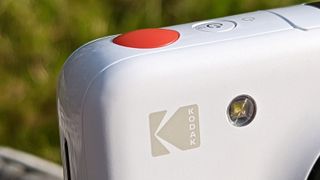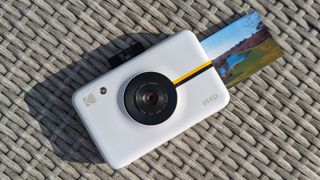Two-minute review
Kodak Step Specs
Film format: 2x3in Zink zero ink
Sensor: 10MP
Lens: Fixed-focus, f/2.8
Shooting modes: Colour, sepia, monochrome, self-timer
Viewfinder: optical, fixed
Battery: li-on rechargeable
It was once one of the camera world’s biggest brands, but Kodak is a relative unknown when it comes to present-day instant photography. The hybrid Kodak Step is hoping to change that and force its way into our guide to the best instant cameras.
Unlike rivals Fuji Instax and Polaroid, the Step eschews analogue film for Zink, or ‘Zero Ink’, prints. Each one has layers of cyan, magenta and yellow ink embedded in the paper, and reacts to heat to produce images.
It relies on a digital sensor, so isn’t as authentic as true instant film, but is significantly cheaper, and the cameras that use it are physically smaller. Essentially, you’re getting most of the fun of instant at a much lower price.
The Step might remind you of the Polaroid Snap, a similar hybrid camera launched back in 2016. Without getting too bogged down over naming rights, it’s essentially built by the same parent company but now sporting a Kodak logo.
With few buttons, no touchscreen and a delightfully simple operation, the Step is a proper point-and-shoot instant camera. Its 10-megapixel sensor is largely on par with a basic modern smartphone, so the digital backups it makes of each photo are more a bonus than a must-have feature, but this doesn’t detract from the charm of its instant prints.
They are nowhere near as detailed or vibrant as Instax film, with noticeable print lines and a real lack of contrast, but the peel-and-stick adhesive back makes them perfect for scrapbookers.
This back-to-basics approach won’t appeal to photographers already familiar with instant film, but the affordable film packs make it a fun way to introduce instant to the younger generation.
Kodak Step: Design and Features
- Shoots 2x3in ZINK photos
- Lightweight, pocket-friendly plastic build
- Simple, intuitive button layout
With no need to expose its film to the light like a traditional instant camera, the Step is significantly smaller than rivals from Fujifilm. The rectangular body is compact enough to fit in a pocket, and the rounded corners make it comfortable enough to grip securely.
All the buttons line the top edge, with the big red shutter button being impossible to miss. The self-timer button next to it doubles as a power button, which flips open the viewfinder as the camera turns on. To turn it off again, you manually flip the viewfinder closed.
The Color mode button toggles between color, sepia and monochrome shooting, which applies to both the digital and physical version of each image. Finally, a frame button adds an Instax-aping white border around your photos.
You load film at the back, sliding down a catch to open the spring-loaded door. Paper sits rather loosely inside the tray, which can lead to some photos not printing perfectly straight (something more noticeable when using the frame mode). On the plus side, the paper doesn’t react to light like Instax film, so you won’t ruin your remaining shots by accidentally opening the door when there’s still paper inside.
Kodak Step: Performance
- Each photo takes around 30 seconds to print
- Offset viewfinder makes composition tricky
- MicroUSB charging
Take a snap and the Kodak Step will print it automatically, taking roughly 30 seconds to spit out the photo. Each image is about the size of a credit card, and you can peel the back off and use them as stickers. Packs of paper are cheaper than Fuji’s Instax Mini, at around 50p per print.
If you’ve fitted a microSD card, a 10-megapixel digital photo gets saved simultaneously. You don’t need one to be able to take instant photos, but annoyingly once you run out of Zink paper you can’t take digital snaps at all until you load a new pack. With no built-in screen you’ll need a computer to review your digital pics, but that’s hardly a shock given the double-digit price.
Framing your subjects is made trickier by the offset viewfinder, which gives no indication as to where the borders of the image will be. It’s particularly troublesome for close-ups, where it’s all too easy to lose limbs or the tops of heads, and there’s no front-facing mirror for lining up selfies. With no digital reminder to remove the lens cap, which is held magnetically to the front of the camera, it’s also quite easy to end up with completely black prints.
The built-in battery is good for around 20 photo prints, or two full packs of ZINK paper. A full charge takes around two hours over microUSB, with the port located at the side of the camera.
Kodak Step: Image Quality
- Prints are colorful but show visible printing lines
- Limited dynamic range, struggles with far-off detail
- Digital images worse than most modern smartphones
Each Zink print looks presentable from arm’s length, but look closer and it’s all too easy to spot the printing lines. It’s most prominent on darker landscape snaps with blue skies that fill the entire frame, and less noticeable on more brightly-exposed photos. Unfortunately, the camera somehow manages to make even well-lit scenes look drab and dimly lit at times.
Colors are closer to traditional 35mm film than the lighter, almost pastel-like hues of some instant film. It only takes a little extra light to blow out a scene, but prints of well-balanced daylight landscapes usually have a good amount of pop. The small digital sensor can quickly begin to struggle as the light goes down, though, with noise ramping up and details quickly lost.
Digital images show a general lack of sharpness, and detail is merely OK. Exposures look more true-to-life here than they do after printing, but highlights are regularly overblown. Any current-generation smartphone can likely do a better job, regardless of light levels.
Kodak Step verdict
There’s a certain charm to the Kodak Step’s simplistic yet modern approach to instant photography. Though its digital images are beaten by any half-decent smartphone, and the prints it produces vary drastically in quality, its affordable nature means anyone looking for an introduction to instant film shouldn’t write it off.
It’s cheaper to run than the Fuji Instax Mini 11, small enough to slide in a pocket, and basic enough that children won’t struggle to use it. It could easily find a place as a family scrapbook companion or a fun addition to parties.
However, Zink paper isn’t as authentic as Instax or Polaroid film, and the digital-first nature won’t appeal to instant purists, who would be better served by the more feature-packed Fujifilm Instax mini 90.





